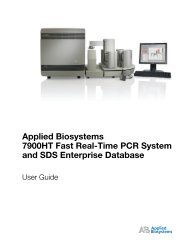DNA quantification and normalization
DNA quantification and normalization
DNA quantification and normalization
Create successful ePaper yourself
Turn your PDF publications into a flip-book with our unique Google optimized e-Paper software.
∗ Incubate the plates for 2 to 5 minutes at room temperature, protected from light,before the analysis on the 7900 HT Sequence Detection System.Analyze the PicoGreen plates in the 7900 HT Sequence Detection System∗ Change to the block module intended for 96 well reaction plates.∗ Make a new SDS document.Assay: allelic discriminationContainer: 96 wells clear plateMarker: PicoGreen, with the detectors SYBR <strong>and</strong> VIC. Passive reference: -none-∗ Connect to the instrument <strong>and</strong> press “Post Read”. Analyze your plate <strong>and</strong> export theresult table.Calculate the concentrations of the samples in excel∗ Open the result table exported from SDS in excel, <strong>and</strong> save it as an excel-file.∗ The PicoGreen fluorescence is most often presented in the “Allele Y Rn” column,double check this with the SDS result plot. Make a dot diagram including the knownCeph concentrations (Y-axis: PicoGreen fluorescence, X-axis: known <strong>DNA</strong>concentration). Insert trend line <strong>and</strong> show equation.∗ Calculate with the help of the equation the sample concentration. Remember to dividethe concentration with 1,5 since this was the volume <strong>DNA</strong> transferred to thePicoGreen plate.Make an import file for <strong>normalization</strong> on Biomek FX∗ Use the template “Mall <strong>DNA</strong>Conc_import file <strong>normalization</strong>” (Analysdata server >PicoGreen folder). Save it as your own <strong>and</strong> store it in your folder in Externa konsulter.Biomek FX <strong>and</strong> 7900 HT090116/CN




